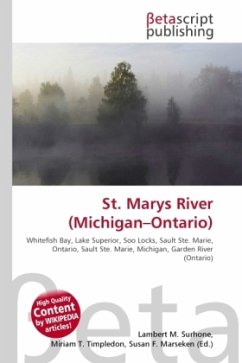
St. Marys River (Michigan-Ontario)
Versandkostenfrei!
Versandfertig in 6-10 Tagen
23,99 €
inkl. MwSt.

PAYBACK Punkte
12 °P sammeln!
High Quality Content by WIKIPEDIA articles! The St. Marys River (French: rivière Sainte-Marie), sometimes written as the St. Mary's River, drains Lake Superior, starting at the end of Whitefish Bay and flowing 120 km (74.5 miles) southeast into Lake Huron, with a fall of 23 feet. For its entire length it is an international border, separating Michigan in the United States from Ontario, Canada. The most important area along the river are the rapids and the twin cities of Sault Ste. Marie, Ontario and Sault Ste. Marie, Michigan, with the most famous man-made feature being the Soo Locks. The rap...
High Quality Content by WIKIPEDIA articles! The St. Marys River (French: rivière Sainte-Marie), sometimes written as the St. Mary's River, drains Lake Superior, starting at the end of Whitefish Bay and flowing 120 km (74.5 miles) southeast into Lake Huron, with a fall of 23 feet. For its entire length it is an international border, separating Michigan in the United States from Ontario, Canada. The most important area along the river are the rapids and the twin cities of Sault Ste. Marie, Ontario and Sault Ste. Marie, Michigan, with the most famous man-made feature being the Soo Locks. The rapids of the St. Marys (Sault Sainte Marie in French) are just below the river's exit from Lake Superior. Two of the Ontario tributaries of this river are the Garden River and the Bar River. Other Canadian tributaries include: Fort Creek, Root River, Little Carp River, Big Carp River, Lower Echo River, Desbarats River, and the Two Tree River. The American tributaries to the St. Mary River are: Gogomain River, Munuscong River, Little Munuscong River, Brimley River, and the Charlotte River.












